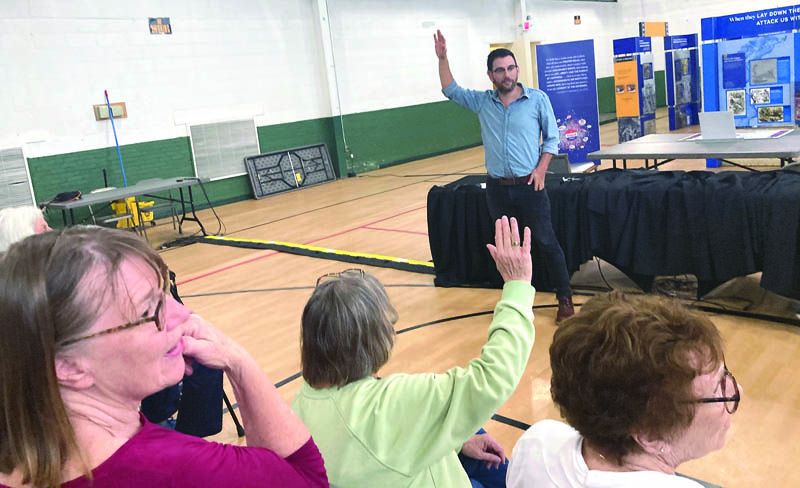The impact of ‘Voices and Votes’ remains after exhibit moves on

Adam Velk, director of the Green McAdoo Cultural Center, leads a discussion about voting and protests. (photo:Ben Pounds )
His presentations relate to “Voices and Votes: Democracy in America,” a traveling Smithsonian Institution exhibit that came to his museum in Clinton March 28 and was on display until Saturday, May 6.
The exhibit took visitors through a tour of voting and election campaigns throughout history.
It also covered other ways people influence the government, such as protests, petitions and lobbying.
Velk’s activities have related to those topics. He said he’s led discussion activities for more school groups than he could count.
More recently, the Anderson County Democratic Party participated in one such activity. He told The Courier-News he would also host the Anderson County Republicans if they asked. To him, the exhibit and activities go beyond partisanship.
“Regardless of where you stand on the political spectrum, voting is one of the best things you can do,” he said. He said that was a lesson from his mother.
“She really drove home the importance of voting for me at a young age,” he said, He called it “a blessing to help inspire people to do the same.” He said his mother would help people get to the polls regardless of their political affiliation.
“It’s important for us to not just get ourselves out to vote but to help each other to vote,” he said. “We look out for our fellow brothers and sisters regardless of where they stand on the political spectrum.
“Our nation in and of itself was founded in a protest in the Boston Harbor,” he said regarding protest, the other focus of the exhibit.
“It’s been a popular exhibit,” he said. “It goes back to what it means to be an American.”
Velk said the exhibit is designed for many different age groups, and so are his activities. The school groups who’ve visited ranged from elementary to high schoolers. He said he leads younger children in discussions and elections about food in order to teach about voting and debate. With older school groups and adults, he asks people if they agree or disagree on questions about voting and protests.
“There are no right or wrong answers; we’re all humans,” he said. “I’m not taking anybody’s side. I’m just facilitating dialogue.”
At the event for Anderson County Democrats, he asked questions about whether they believed convicted felons should vote, whether voting should be mandatory, and whether voting is a right or a privilege.
Regarding protest, he asked about the circumstances in which people would feel comfortable attending protests, including if there was a larger counterprotest, if some people nearby were destroying property, and if it would cause an argument with family.
He said these are similar questions to the ones he asked school groups.
With smaller student groups, he often has them physically run between different spots if their answer is “yes” and “no.” Larger groups like the Democrats just raised hands.
The traveling exhibit included photos, videos, touch screens and interactive games such as a version of the test people take to become U.S. citizens.
It also included objects like magazines, and campaign and protest materials. It’s a version of an exhibit in the Smithsonian’s National Museum of American History.
“Our democracy demands action, reaction, vision, and revision as we continue to question how to form ‘a more perfect union.’ How do you participate as a citizen? From the revolution and suffrage, to civil rights and casting ballots, everyone in every community is part of this ever-evolving story – the story of democracy in America,” an official Smithsonian website states.

